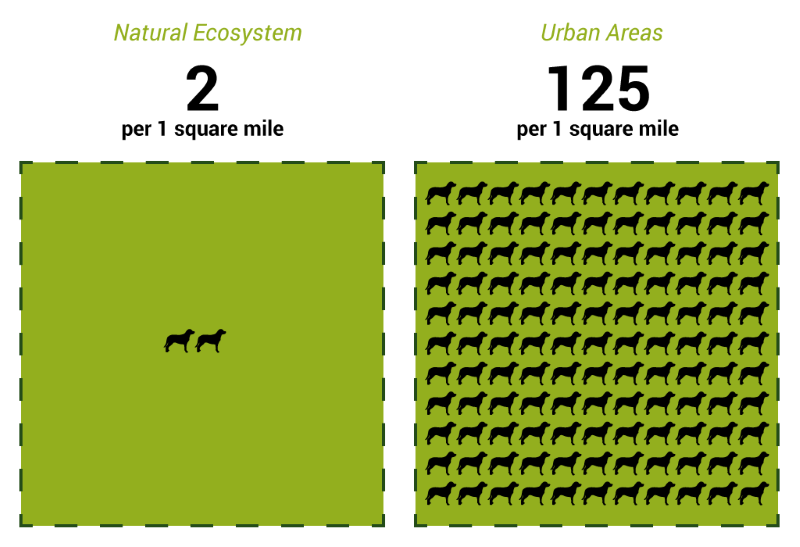Every animal poops.
Okay, that might be a given, but have you ever stopped to think just how much fecal waste is dispensed onto our planet every single day?
Generally, the larger the animal, the more poo will come out as they need to take in a larger amount of food, but there are also several other factors that influence the amount excreted such as their type of digestive system, level of activity, age, as well as their surrounding climate and environment.
In order to show how much an animal poops and how the output of each species can drastically differ, we’ve compared the amount of poo to its equivalent weight in fruit!
(Listed from one of the smallest animals to one of the largest animals in existence today)
Mice poop the equivalent of 1 blueberry per day.

25 g
4 g
per day
0.5 g
per day
| Diet | (Omnivore) Grains, fruits and seeds. |
|---|---|
| Count | (WORLDWIDE) The house mouse is probably the most widespread invasive mammalian species, ubiquitous worldwide. An undetermined population in the billions produces at least 2 million pounds of waste per day, over 712 million pounds per year (646 billion blueberries) |
| Fact | Mice and rats possess many differences including their bathroom habits. Mice may excrete up to 80 droppings a day, while rats may only produce half that amount. Despite releasing less in numbers, rat droppings are larger in size and weigh almost 10 times more than that of mice! |
Chickens poop the equivalent of 7 cherries per day.

5 lbs
0.25 lbs
per day
0.125 lbs
per day
| Diet | (Omnivore) Berries, insects, worms, grains, seeds. |
|---|---|
| Count | (IN THE U.S.) It is hard to estimate the population of chickens as most only live 45 days at a time within the meat industry, but if one were to assume that 1 billion chickens exist at any given time, they produce 125 million pounds of waste per day, 44.5 billion pounds per year (2.5 trillion cherries) |
| Fact | Every living creature has to excrete their waste on a regular basis, but each species does it a bit differently. While us humans separate our urine from our feces, other animals such as reptiles and birds (including chickens) excrete all of their waste out of the same passageway. Instead of releasing uric acid through pee, it is discharged in feces as a dry powdery substance. As a result, chicken poop comes out brown with a white cap on top and no liquid is expelled. |
Rabbits poop the equivalent of 5 strawberries per day.

5 lbs
0.2 lbs
per day
0.13 lbs
per day
| Diet | (Herbivore) Fruit, vegetables, hay, grass… and the occasional pellets. |
|---|---|
| Count | (WORLDWIDE) It may be hard to estimate how many rabbits exist between the domesticated, laboratory used, and feral. If one can assume there is at least 1 billion worldwide, that’s 130 million pounds of waste per day, 46 billion pounds per year (1.74 trillion strawberries). |
| Fact | Some people may take a multivitamin once a day to ensure their body is getting the proper nutrients, but rabbits can naturally produce their own multivitamin… and it comes out in the form of poop. Separate from their typical round pellets of poo, once a day a rabbit will excrete a special piece of feces called a cecotrope, a nutrient-rich stool resulting from the fermentation of food in a part of their digestive system called the cecum. The rabbit then quickly reingests the waste, absorbing the much needed nutrients to maintain a healthy body. |
Cats poop the equivalent of 1 navel orange per day.

10 lbs
0.2 lbs
per day
0.3 lb
per day
| Diet | (Carnivore) Various meat & fish. |
|---|---|
| Count | (IN THE U.S.) 96 million cats produce 28,800,000 lbs of waste per day, 10.2 billion pounds per year (34 billion oranges) |
| Fact | Ever wonder why cats will naturally want to relieve themselves in the litter box? It is a cat’s innate instinct to avoid attracting attention from nearby predators and litter provides the perfect substance to cover up their poops’ odor. Inversely, wild cats may purposely not bury their waste to show other felines in the area that the territory has been claimed. |
Dogs poop the equivalent of 2 red apples per day.

40 lbs
0.8 lbs
per day
0.75 lb
per day
| Diet | (Omnivore) Raw meat, vegetables and fruit. |
|---|---|
| Count | (IN THE U.S.) 80 million dogs produce 60 million pounds of waste per day, 21.3 billion pounds per year (52.4 billion apples) |
| Fact | Make sure to bag that poo! The majority of water pollution comes from runoff sources like oil from motor vehicles, chemical fertilizers and dog waste. These pollutants that lay situated on the ground are washed into water bodies when it rains, contaminating rivers and streams and harming the aquatic life that reside there. |
Humans poop the equivalent of 1 ½ bananas per day.

196 lbs
5.5
of body weight
0.49 lb
per day
| Diet | (Omnivore) Grains, dairy, veg, fruit, oils… occasional fast food. |
|---|---|
| Count | (IN THE U.S.) 320 million people produce 156.8 million lbs of waste per day, 55.8 billion lbs per year (169 billion bananas) |
| Fact | Could human waste be powering our cars in the future? Not only do our current sewage systems capture the waste we flush down the toilet, but it also captures the gas that is released as that waste breaks down. Engineers have discovered how to feed this biogas through a device that converts it to electricity, a resource that can be used to power electric cars. Although, the inventors are still working out the kinks, a prototype has been made to show off such a creative approach towards creating renewable energy. |
Pigs poop the equivalent of 10 coconuts per day.

250 lbs
6 lbs
per day
15 lbs
per day
| Diet | (Omnivore) Vegetables, fruit, bugs (corn, soybean if on farm). |
|---|---|
| Count | (IN THE U.S.) 68 million pigs in the farming industry plus 5 million wild boars produce over 1 billion lbs of waste per day, 390 billion lbs per year (260 billion coconuts) *not including domesticated pigs |
| Fact | Researchers have discovered pig manure possesses certain oils that create a strong viscous material similar to that of petroleum. When mixing these oils with sand or gravel, it can produce a substance comparable to traditional asphalt. If this new combination can prove to withstand the daily abuse from cars driving upon it, repaving roads with pig manure will not only drastically reduce our use of petroleum, but also be a solution as for where to put the billions of pounds of pig manure produced from industrial-scale farms. |
Horses poop the equivalent of 15 pineapples per day.

1,000 lbs
20 lbs
per day
30 lbs
per day
| Diet | (Herbivore) Primarily hay and grass. |
|---|---|
| Count | (IN THE U.S.) 9 million horses produce 270 million pounds of waste per day, 96 billion pounds per year (48 billion pineapples) |
| Fact | Before the invention of the automobile, horses were the most common method of transportation, and by the late nineteenth century, more than 150,000 horses would be commuting the streets of New York City, each one releasing about 20 lbs of manure per day. Collectively their daily waste added up to a staggering 3 million pounds, filling up the city’s roads and sidewalks. Although there were workers paid to remove the waste, it became too overwhelming, and the city’s residents soon feared they would be drowning in horse manure within just a few short years. Luckily motorized vehicles swooped in at the turn of the century, saving the day and ending the horse manure crisis. |
Cows poop the equivalent of 4 watermelons per day.

1390 lbs
28 lbs
per day
80 lbs
per day
| Diet | (Herbivore) Hay, grain, silage. |
|---|---|
| Count | (IN THE U.S.) 98 million cattle produce 7.8 billion pounds of waste per day, 2.8 trillion pounds per year (140 billion watermelons) |
| Fact | We’ve all heard about the Oregon Trail where settlers during the mid 1800’s traveled in wagons through what is now Missouri, Kansas, Nebraska, Wyoming, and Idaho. But what you might not have heard is that their main source for heat… was poop. Given the name buffalo chips, dry pieces of buffalo and cow dung were collected to use as a replacement for the sparse firewood in the wide open plains. Buffalo chips served as fuel for fires and cooking and surprisingly produced an odor-free flame. |
Elephants poop the equivalent of 33 cantaloupes per day.

10,000 lbs
400 lbs
per day
100 lbs
per day
| Diet | (Herbivore) Leaves, bark, twigs, shrubs and bushes, fruits, roots and flowers. |
|---|---|
| Count | (AFRICA) An estimated 500,000 elephants produce 50 million lbs of waste per day, 17.8 lbs per year (5.9 billion cantaloupes) |
| Fact | Are you a coffee lover? Well, one of the world’s most expensive coffee comes from poop… to be clear, it is not made of poop, but found in poop. The company, Black Ivory Coffee, sources their beans from the manure of a group of elephants located in Thailand. Coffee beans are mixed in with mashed up fruit and fed to the elephants where their large stomach acts as a powerful machine that produces acid to break down protein and fermentation to break down cellulose, both reducing the bitterness and enhancing the fruity content. Once excreted, a lucky worker gets to the sort through the feces and pick out the beans to then be thoroughly washed and dried before being roasted. If you are brave enough to give it a try, you will also have to be willing to pay the hefty price of $50 a cup or $500 per pound. |

 So just how much dog poop is in Asheville?
So just how much dog poop is in Asheville?